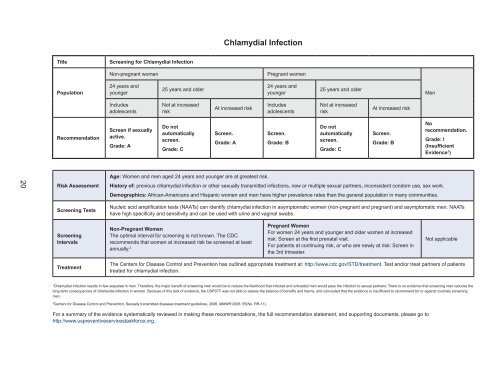1DpwC8F
1DpwC8F
1DpwC8F
Create successful ePaper yourself
Turn your PDF publications into a flip-book with our unique Google optimized e-Paper software.
Chlamydial Infection<br />
Title<br />
Screening for Chlamydial Infection<br />
Non-pregnant women<br />
Pregnant women<br />
Population<br />
24 years and<br />
younger<br />
25 years and older<br />
24 years and<br />
younger<br />
25 years and older<br />
Men<br />
Includes<br />
adolescents<br />
Not at increased<br />
risk<br />
At increased risk<br />
Includes<br />
adolescents<br />
Not at increased<br />
risk<br />
At increased risk<br />
Recommendation<br />
Screen if sexually<br />
active.<br />
Grade: A<br />
Do not<br />
automatically<br />
screen.<br />
Grade: C<br />
Screen.<br />
Grade: A<br />
Screen.<br />
Grade: B<br />
Do not<br />
automatically<br />
screen.<br />
Grade: C<br />
Screen.<br />
Grade: B<br />
No<br />
recommendation.<br />
Grade: I<br />
(Insufficient<br />
Evidence 1 )<br />
20<br />
Risk Assessment<br />
Age: Women and men aged 24 years and younger are at greatest risk.<br />
History of: previous chlamydial infection or other sexually transmitted infections, new or multiple sexual partners, inconsistent condom use, sex work.<br />
Demographics: African-Americans and Hispanic women and men have higher prevalence rates than the general population in many communities.<br />
Screening Tests<br />
Nucleic acid amplification tests (NAATs) can identify chlamydial infection in asymptomatic women (non-pregnant and pregnant) and asymptomatic men. NAATs<br />
have high specificity and sensitivity and can be used with urine and vaginal swabs.<br />
Screening<br />
Intervals<br />
Non-Pregnant Women<br />
The optimal interval for screening is not known. The CDC<br />
recommends that women at increased risk be screened at least<br />
annually. 2<br />
Pregnant Women<br />
For women 24 years and younger and older women at increased<br />
risk: Screen at the first prenatal visit.<br />
For patients at continuing risk, or who are newly at risk: Screen in<br />
the 3rd trimester.<br />
Not applicable<br />
Treatment<br />
The Centers for Disease Control and Prevention has outlined appropriate treatment at: http://www.cdc.gov/STD/treatment. Test and/or treat partners of patients<br />
treated for chlamydial infection.<br />
1<br />
Chlamydial infection results in few sequelae in men. Therefore, the major benefit of screening men would be to reduce the likelihood that infected and untreated men would pass the infection to sexual partners. There is no evidence that screening men reduces the<br />
long-term consequences of chlamydial infection in women. Because of this lack of evidence, the USPSTF was not able to assess the balance of benefits and harms, and concluded that the evidence is insufficient to recommend for or against routinely screening<br />
men.<br />
2<br />
Centers for Disease Control and Prevention, Sexually transmitted diseases treatment guidelines, 2006. MMWR 2006. 55(No. RR-11).<br />
For a summary of the evidence systematically reviewed in making these recommendations, the full recommendation statement, and supporting documents, please go to<br />
http://www.uspreventiveservicestaskforce.org.


